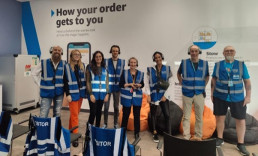On October 13 and 14, IDC Retail Insights Team Europe joined AWS for a two days’ AWS London Analyst Tour to give first-hand examples of how technology enables innovation of the entire retail value chain, transforming retail fulfillment and physical store operations to better serve customer experience in real-time.
On day one of the tour, the analysts visited two fulfillment centers, Ocado’s CFC4 fulfillment center in Erith, and Amazon’s Tilbury fulfillment center (FC), while stores in Central London were the focus of day two with visits at Amazon Fresh in Hackney, Sainsbury’s in Holborn and Nike Town in Oxford Circus
In this post, we briefly summarize what we saw during the tour and why this is significant for the retail industry.
Automation for Efficient and Sustainable eCommerce Fulfillment: Day One, Ocado’s CFC4
On a cloudy Thursday morning, we left St Pancras for a one-hour minivan ride to Ocado’s CFC4 in Erith, East London. The site, a 600,000 square feet fulfillment center, is the company’s largest CFC globally and does stand out for the high level of automation that characterizes the facility.
Erith’s CFC4 is an outstanding example of the application of Ocado Smart Platform (OSP) in large-scale grocery distribution. OSP is Ocado’s proprietary technology that leverages a combination of AI, machine learning, robotics, IoT and data science to boost efficiency and flexibility in highly complex end-to-end eGrocery operations.
According to Ocado, OSP improves dramatically efficiency of fulfilment operations—99.9% fulfilment accuracy vs about 80% of other leading UK supermarkets—and ensures waste reduction by making operations more sustainable. Logistics and fulfillment operations play a huge role in meeting customers’ expectations, improving efficiencies and making operations sustainable, currently among the top retailers’ priorities.
That is why more and more retailers are deploying advanced analytics and automation to streamline logistics and fulfillment. Over 70% of retailers confirm their plans to adopt AI and cognitive for order orchestration and robotics for warehouse automation, latest IDC research reveals.
As we visited the facility, what stood out was the large area dominated by a seemingly immense grid surface on which thousands of bots move around at lightning speed in apparently random directions. On the grid, bots travel at a speed of 4 meters a second, with 5 millimetres of distance between them.
Of course, their journey on the grid is not random. Bots are orchestrated, not autonomous, and operate through a proprietary RF solution designed by Ocado to ensure ultra-low latency which is needed given the high density of the bots on the grid and the speed at which they move around. Ocado partnered with AWS to run its thousands of OSP’s microservices in the cloud and ensure bots and operations orchestration.
The circa 3,000 robots are working non-stop for 20 hours a day, picking up to 2 million food items in a shift from 50,000 individual chilled and general grocery products. An average 45 items grocery order is completed in 5 minutes. Scalability and the impossibility of a single point of failure, both ensured by the modular nature of the OSP and its orchestration on AWS cloud, is the huge advantage of Ocado’s technology stack, which makes it suitable not just for Ocado’s operations but also to the requirements of other grocery retailers worldwide—including Groupe Casino, Auchan, AEON and Kroger, who partnered with Ocado to power their eGrocery operations.
Empowering Workforce in eCommerce Logistics: Day One, Amazon’s Tilbury FC
Sun was out as we approached Amazon’s FC in Tilbury in the afternoon. The Tilbury FC is one of the largest European Amazon’s TC, with 2.2 million square feet facility over 4 floors.
The FC is highly automated with extensive use of technology including robotics, AI and computer vision in all aspects of operations, all brought together and enabled by AWS cloud-native services. Over 2,000 people are employed at any given time in the facility, showing how despite the high level of automation, the employee remains key in retail fulfilment operations.
The FC provides a great example of augmented workforce by showing how technology is helping people to work efficiently. According to latest IDC Retail Insight research, 43% of retailers consider as a high priority to empower their staff by providing employee experience services, with the right technologies and tools to perform tasks timely.
We started our visit from the sorting stations, located on level 2,3 and 4. At this stage, staff pick items from boxes received from the inbound area, and put the products in yellow stacks based on their weight. Lights are guiding the staff by showing them where to place the item in the stack. The stacks are then moved around by an army of about 4,000 autonomous bots that fit under the stack and use AI and algorithms to sequence the tasks they need to perform.
QR codes printed on the floor are scanned by bots’ cameras and sensors to make them find their way around the massive facility area. While bots are fully autonomous and not controlled by humans, employees in control areas—workstations that look like bank’s trading rooms on which operation flows are shown on numerous displays—overlook every aspect of the process and alert colleagues on the shopfloor if any issue arises.
The next step is the picking area, in which staff collect items from the stacks and place them in black boxes, or totes, in a reverse process. The products are picked in sequence, so at this stage, the staff is not putting together a single order, but rather an aggregate. The boxes are then placed on spiral conveyor belts that move the totes down to the ground floor to the packing stations, where employees pick items from the totes and place them in pigeon-hole wall units, in which each hole corresponds to single customer orders.
On the other side of the wall, staff members pick items from the holes, pack them in single orders and put barcodes on the boxes for identification.
In the last mile of the process, the boxes are placed on a conveyor belt in the slam area, where robotic arms scan the labels and check if the weight of the box matches the content the label describes – if not, the box gets expelled from the belt for a member of staff to check it up. At the end of the conveyor belt, employees pick the boxes and place them in containers that are forklifted on outbound trucks to be taken out of the facility to sortation centers closer to the end shopper for last-mile delivery.
Unleashing the New Role of the Physical Store: Day Two, Central London Stores Tour
Hailed by another cloudy morning, day 2 focused on the application of technology in physical store environments to deliver more engaging, frictionless, shopping journeys and improve the customer experience. The physical store remains crucial in omnichannel retail, but its role is changing as the brick-and-mortar store becomes increasingly connected and integrated with the entire omnichannel experience. The visit offered great examples of how the role of the physical store is evolving in the context of today’s omnichannel shopping complexity, as we cover more in-depth in IDC PeerScape: Practices to Enable the New Role of the Physical Store.
We started our tour at Amazon Fresh convenience store in Hackney, one of the most recent additions to Amazon’s autonomous stores network in London, and continued the morning with a visit to Sainsbury’s first autonomous store, Smartshop Pick & Go, in Holborn.
The two stores deploy AWS technology—cameras, sensors, AI, and computer vision— to offer a fully automated grocery shopping experience that removes any possible point of friction, making the trip to the shop quick and effortless. Shoppers can scan their app to be identified as they enter the store, pick up items from shelves, and walk out without going through checkouts as the technology detects shoppers’ purchases and charges them accordingly through their app.
We ended our tour with Nike Town in Oxford Street, the company’s flagship store for the UK, for an example of what experiences technology enables in non-grocery physical store shopping. While with the grocery stores priority was given to reducing frictions, the focus of the application of the technology in the sportswear and lifestyle brick and mortar retail store rests on the personalization of the customer journey and in merging digital and physical.
The Nike App is the interface that enables the shopper to access personalized offers, benefits, and experiences, such as Find and Research, which enables shoppers to reserve an item on the app for in-store collection, Nike Scan, through which shoppers can scan barcodes on the item to access product information such as sizes and color availability and request store staff to try the item on, and Triggered Reward, which sends shoppers personalized alerts on exclusive promotions based on their location in the store.
Key Takeaways: Learning Points from the AWS London Analyst Tour
What we saw during the AWS London Analyst Tour are significant examples of how technology is instrumental for retailers to streamline future-proof omnichannel retail operations. As IDC’s recent survey results show, over the next two years retailers plan to invest in incremental and emerging technologies to improve new customer loyalty mix and CX personalization, enhancing sensory and immersive commerce.
At the same time, the Tour confirmed how leading retailers are already preparing for the future of omnichannel retail. Ocado showed us how to drastically increase efficiencies and pursue sustainability goals through clever automation.
Amazon reminded us that automation and AI need to empower the workforce, as staff remains key to navigating the complexity of today’s omnichannel fulfillment. Finally, the visits to Amazon Fresh, Sainsbury’s and Nike Town are significant examples of how to transform the physical store to make it a central piece of the new omnichannel customer journey.


